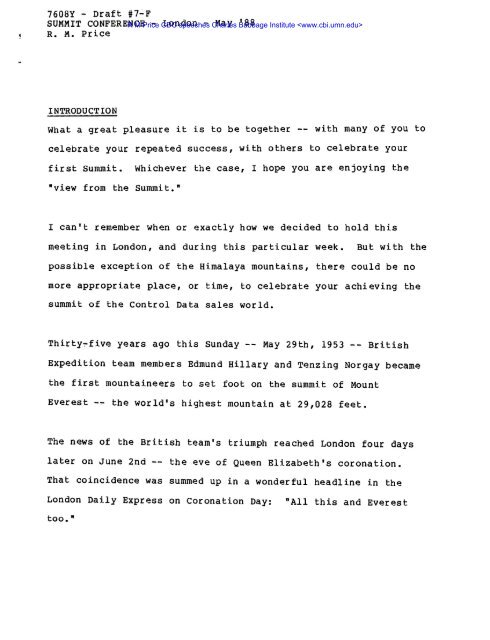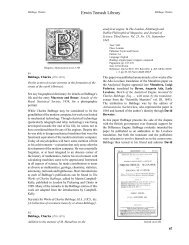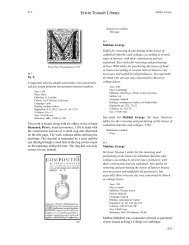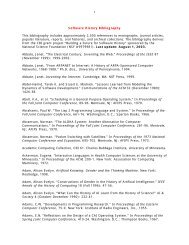The news of the British team's triumph reached London four days
The news of the British team's triumph reached London four days
The news of the British team's triumph reached London four days
You also want an ePaper? Increase the reach of your titles
YUMPU automatically turns print PDFs into web optimized ePapers that Google loves.
7608Y - Draft #7-F<br />
SUMMIT CONFERENCE R M Price - CDC <strong>London</strong> speeches - Charles May Babbage '88 Institute <br />
R. M. Price<br />
INTRODUCTION<br />
What a great pleasure it is to be toge<strong>the</strong>r — with many <strong>of</strong> you to<br />
celebrate your repeated success, with o<strong>the</strong>rs to celebrate your<br />
first Summit. Whichever <strong>the</strong> case, I hope you are enjoying <strong>the</strong><br />
"view from <strong>the</strong> Summit."<br />
I can't remember when or exactly how we decided to hold this<br />
meeting in <strong>London</strong>, and during this particular week. But with <strong>the</strong><br />
possible exception <strong>of</strong> <strong>the</strong> Himalaya mountains, <strong>the</strong>re could be no<br />
more appropriate place, or time, to celebrate your achieving <strong>the</strong><br />
summit <strong>of</strong> <strong>the</strong> Control Data sales world.<br />
Thirtyrfive years ago this Sunday — May 29th, 1953 -- <strong>British</strong><br />
Expedition team members Edmund Hillary and Tenzing Norgay became<br />
<strong>the</strong> first mountaineers to set foot on <strong>the</strong> summit <strong>of</strong> Mount<br />
Everest — <strong>the</strong> world's highest mountain at 29,028 feet.<br />
<strong>The</strong> <strong>news</strong> <strong>of</strong> <strong>the</strong> <strong>British</strong> <strong>team's</strong> <strong>triumph</strong> <strong>reached</strong> <strong>London</strong> <strong>four</strong> <strong>days</strong><br />
later on June 2nd — <strong>the</strong> eve <strong>of</strong> Queen Elizabeth's coronation.<br />
That coincidence was summed up in a wonderful headline in <strong>the</strong><br />
<strong>London</strong> Daily Express on Coronation Day: "All this and Everest<br />
too."
2 -<br />
Think for a moment what it would have been like to be here when<br />
that headline appeared in 1953. We would've, "in a span <strong>of</strong> less<br />
than twenty-<strong>four</strong> hours...lived through one <strong>of</strong> <strong>the</strong> most remarkable<br />
conjunctures <strong>of</strong> events in all history." That's <strong>the</strong> way <strong>The</strong> New<br />
York Times put it in an editorial. <strong>The</strong> Times added: "Nothing<br />
less can characterize that wonderful combination <strong>of</strong> <strong>the</strong> conquest<br />
<strong>of</strong> <strong>the</strong> last unconquered spot on earth and <strong>the</strong> dawn <strong>of</strong> a new<br />
Elizabethan era."<br />
So I can think <strong>of</strong> no more suitable thing to do this night than to<br />
take a few moments to relive <strong>the</strong> conquest <strong>of</strong> Everest.<br />
Not only was it a truly historic moment, <strong>the</strong> story is as<br />
instructive today in its fundamentals as it was 35 years ago.<br />
OF MOUNTAIN AND MEN<br />
<strong>The</strong> story <strong>of</strong> Mount Everest had a distinctly <strong>British</strong> flavor long<br />
before <strong>the</strong> summit was scaled in 1953.<br />
<strong>The</strong> mountain, known to Tibetans as Chamolungma, or "Goddess Mo<strong>the</strong>r<br />
<strong>of</strong> <strong>the</strong> World", was named after Sir George Everest, a <strong>British</strong><br />
surveyor who conducted <strong>the</strong> first scientific survey <strong>of</strong> <strong>the</strong><br />
Himalayas in <strong>the</strong> 1830's.<br />
R M Price CDC speeches Charles Babbage Institute <br />
<strong>The</strong> <strong>British</strong> mounted <strong>the</strong>ir first formal expedition in 1921. It was<br />
a general reconnaissance <strong>of</strong> <strong>the</strong> approaches to Everest.
3 -<br />
<strong>The</strong>y made a full-scale attempt to climb it a year later, reaching<br />
a height <strong>of</strong> 27,300 feet. That expedition ended, unfortunately,<br />
when an avalanche killed seven climbers, <strong>the</strong> first <strong>of</strong> many <strong>the</strong><br />
mountain was to claim.<br />
A <strong>British</strong> team tried again in 1924. Three assaults on <strong>the</strong> summit<br />
were made. On <strong>the</strong> second attempt, one climber got within 900<br />
vertical feet <strong>of</strong> <strong>the</strong> top. George Mallory, a well-known<br />
mountaineer, and Andrew Irvine, a young man <strong>of</strong> 22, made <strong>the</strong> third<br />
attempt. <strong>The</strong>y never returned.<br />
No trace <strong>of</strong> <strong>the</strong>m was found until 1933. <strong>The</strong>ir disappearance was<br />
cloaked in mystery and <strong>the</strong>re was some speculation <strong>the</strong>y had <strong>reached</strong><br />
<strong>the</strong> summit based on when <strong>the</strong> <strong>four</strong>th <strong>British</strong> expedition team<br />
discovered an ice ax at about 27,500 feet.<br />
Expeditions continued until <strong>the</strong> outbreak <strong>of</strong> World War II. All <strong>of</strong><br />
<strong>the</strong> attempts were from <strong>the</strong> north through Tibet. That route was<br />
closed after <strong>the</strong> war by <strong>the</strong> Chinese who had gained control <strong>of</strong><br />
Tibet.<br />
R M Price CDC speeches Charles Babbage Institute <br />
Meanwhile, Nepal, which is on <strong>the</strong> south side <strong>of</strong> Everest, opened<br />
its frontiers to foreign mountaineers for <strong>the</strong> first time.
<strong>The</strong> <strong>British</strong> conducted a reconnaissance <strong>of</strong> <strong>the</strong> sou<strong>the</strong>rn approach in<br />
1951. A year later, Swiss teams made two full-scale attempts on<br />
Everest from <strong>the</strong> south side. <strong>The</strong> first attempt in <strong>the</strong> spring<br />
ended at a record height <strong>of</strong> 28,250 feet. One <strong>of</strong> <strong>the</strong> climbers was<br />
Tenzing Norgay. Tenzing commented regarding <strong>the</strong> attempt, "We<br />
could perhaps have gone to <strong>the</strong> top. But we could not have come<br />
down again."<br />
R M Price CDC speeches Charles Babbage Institute <br />
<strong>The</strong> stage was now set for <strong>the</strong> dramatic <strong>triumph</strong> in 1953. <strong>The</strong><br />
eleventh expedition was led by John Hunt, a <strong>British</strong> military<br />
<strong>of</strong>ficer. But before describing <strong>the</strong> victory, let me tell you a<br />
little bit about <strong>the</strong> mountain itself.<br />
According to Hunt, o<strong>the</strong>r peaks demand more actual climbing than<br />
Everest. He pointed out: "Alaska's Mount McKinley, for example,<br />
measures 19,000 feet from its lowland base, while Everest rises<br />
only about 12,000 above <strong>the</strong> 17,000-foot high Tibetan plateau.<br />
Fierce Himalayan winds are a major obstacle, but <strong>the</strong> Scottish<br />
Highlands, battered by <strong>the</strong> North Atlantic's hurricanes, endure<br />
gales as terrible. Everest's crags and crevasses test any man's<br />
ability, but half a dozen Alpine peaks <strong>of</strong>fer technical problems <strong>of</strong><br />
greater severity. Everest can chill a person to <strong>the</strong> marrow with<br />
summer temperatures down to minus 40 degrees Fahrenheit at night;<br />
but on <strong>the</strong> Greenland icecap and elsewhere explorers have lived<br />
through cold worse by 30 or 40 degrees."
Hunt explained:<br />
5 -<br />
R M Price CDC speeches Charles Babbage Institute <br />
"What makes Everest murderous is <strong>the</strong> fact that its cold, its wind,<br />
and its climbing difficulties converge upon <strong>the</strong> mountaineer at<br />
altitudes which have already robbed him <strong>of</strong> resistance...<br />
"Above 25,000 feet <strong>the</strong> climber's heavy legs seem riveted to <strong>the</strong><br />
ground, his pulse races, his vision blurs, his ice ax sags in his<br />
hand like a crowbar. To scoop up snow in a pan for melting looms<br />
as a monumental undertaking."<br />
"On Everest," ano<strong>the</strong>r climber said, "it is an effort to cook, an<br />
effort to talk, an effort to think, almost too much <strong>of</strong> an effort<br />
to live."<br />
Why would anyone want to climb Mount Everest?<br />
Mallory answered that question on a lecture tour <strong>of</strong> <strong>the</strong> United<br />
States in 1923, with his classic reply: "Because it is <strong>the</strong>re."<br />
Mallory is also responsible for one <strong>of</strong> <strong>the</strong> more vivid descriptions<br />
<strong>of</strong> Everest. During <strong>the</strong> 1921 reconnaissance expedition, Mallory<br />
viewed from <strong>the</strong> Tibetan side <strong>the</strong> crevasse-riven icefall and abrupt<br />
ice slopes to <strong>the</strong> south that would confront <strong>the</strong> 1953 expedition<br />
team. He described <strong>the</strong> sight as "one <strong>of</strong> <strong>the</strong> most awful and<br />
utterly forbidding scenes ever observed by man" and concluded that<br />
it was unclimbable.
THE CONQUEST AND ITS LESSONS<br />
6 -<br />
How do you climb a mountain that for 32 years has defied <strong>the</strong><br />
world's best mountaineers and, in <strong>the</strong> process, claimed <strong>the</strong> lives<br />
<strong>of</strong> at least 16 <strong>of</strong> <strong>the</strong>m? Put slightly differently: How do you<br />
climb a mountain up a route that, in <strong>the</strong> opinion <strong>of</strong> one <strong>of</strong> <strong>the</strong><br />
best <strong>of</strong> <strong>the</strong>se courageous mountaineers, is "unclimbable"?<br />
I suspect you know <strong>the</strong> answers to those questions. We are here at<br />
this Summit because we know what it takes. It starts with a sound<br />
strategy based on diligently ga<strong>the</strong>red and analyzed data about <strong>the</strong><br />
objective.<br />
R M Price CDC speeches Charles Babbage Institute <br />
<strong>The</strong> strategy <strong>of</strong> <strong>the</strong> 1953 team was based on all <strong>the</strong> data and<br />
experience <strong>of</strong> <strong>the</strong> 10 previous expeditions, as well as data from<br />
aerial photographs and detailed meteorlogical information.<br />
<strong>The</strong> Swiss pioneering <strong>of</strong> <strong>the</strong> route gave <strong>the</strong> <strong>British</strong> confidence that<br />
<strong>the</strong> sou<strong>the</strong>rn approach was, indeed, "climbable".<br />
But ultimately, success <strong>of</strong> <strong>the</strong> strategy depended on timing. As<br />
John Hunt put it, "<strong>The</strong> mountain's subtlest defense is <strong>the</strong><br />
prohibition it places upon climbing it at all except during a few<br />
unpredictable <strong>days</strong> in late spring between <strong>the</strong> lulling <strong>of</strong> <strong>the</strong><br />
[winter] gales ... too brutal for mortal men to face ... and <strong>the</strong><br />
arrival <strong>of</strong> <strong>the</strong> snow laden monsoon." So <strong>the</strong> timing had to be very
7 -<br />
R M Price CDC speeches Charles Babbage Institute <br />
precise. But despite <strong>the</strong> intense time pressure, Hunt's strategy<br />
was to push methodically up <strong>the</strong> mountain and carefully position<br />
supplies at very advanced camps so that <strong>the</strong> final assault could be<br />
made by well prepared and well rested teams. In contrast, <strong>the</strong><br />
Swiss in <strong>the</strong> spring <strong>of</strong> 1952 dispensed with advanced camps and<br />
tried to rush <strong>the</strong> summit. At its highest camp <strong>the</strong> night before<br />
<strong>the</strong>ir final assault <strong>the</strong> Swiss team had no sleeping bags, no<br />
mattresses, no stove and nothing to drink except snow melted by<br />
candle flames. Exhaustion <strong>the</strong> next day forced <strong>the</strong>m to abort less<br />
than 800 feet from <strong>the</strong> summit.<br />
So Hunt had a carefully thought-out strategy based on that<br />
experience.<br />
THE RIGHT PRODUCTS<br />
And <strong>the</strong>re was <strong>the</strong> matter <strong>of</strong> having <strong>the</strong> right products. For<br />
example, <strong>the</strong> equipment used by his group featured state-<strong>of</strong>-<strong>the</strong>-art<br />
technology, especially <strong>the</strong> oxygen apparatus. <strong>The</strong> oxygen sets<br />
carried by Hillary and Tenzing were considerably lighter in weight<br />
and more efficient than models used by earlier expeditions. <strong>The</strong><br />
right products truly helped.
PEOPLE<br />
8 -<br />
<strong>The</strong> success <strong>of</strong> Hunt's strategy finally depended on <strong>the</strong> people he<br />
recruited. In choosing people to match Mount Everest, Hunt said<br />
he looked for climbers who combined youth, stamina and Himalayan<br />
experience with "a quite unusual endowment <strong>of</strong> selflessness and<br />
patience."<br />
However, <strong>the</strong> success <strong>of</strong> those people also involved three o<strong>the</strong>r<br />
factors: perseverance, risk-taking and teamwork.<br />
<strong>The</strong> <strong>British</strong> epitomized perseverance in <strong>the</strong>ir 32-year pursuit <strong>of</strong><br />
<strong>the</strong> top <strong>of</strong> Mount Everest. <strong>The</strong> one person, however, who best<br />
demonstrated perseverance was Tenzing. He had been on six<br />
previous Everest expeditions, two <strong>of</strong> <strong>the</strong>m <strong>the</strong> year before with <strong>the</strong><br />
Swiss.<br />
<strong>The</strong> willingness to take risks is vital to success in any<br />
endeavor. Of course, none <strong>of</strong> our jobs demand taking <strong>the</strong> type <strong>of</strong><br />
life-?threatening risks that are inherent in mountain climbing.<br />
But still it's instructive to note a decision Hillary made on a<br />
steep, snow-tcovered ridge during <strong>the</strong> final climb.<br />
Halfway up it, he turned to Tenzing and said: "What do you think<br />
<strong>of</strong> it?"<br />
R M Price CDC speeches Charles Babbage Institute <br />
Tenzing replied: "I don't like it at all."
- 9 -<br />
R M Price CDC speeches Charles Babbage Institute <br />
Hillary decided to go on, explaining his decision this way: "In<br />
ordinary mountaineering terms, <strong>the</strong> risk [wasn't] justifiable...but<br />
this [was] Everest, and on Everest you sometimes have to take <strong>the</strong><br />
long odds because <strong>the</strong> goal is worth it."<br />
Teamwork.<br />
That 1953 <strong>British</strong> group succeeded in large part because, as one<br />
climber put it, "No expedition...enjoyed better teamwork."<br />
That teamwork resulted from John Hunt's leadership and <strong>the</strong><br />
conviction he instilled in team members that each person was<br />
doing, as one <strong>of</strong> <strong>the</strong>m explained it: "...<strong>the</strong> one vital job <strong>of</strong> <strong>the</strong><br />
expedition, even if it was peeling potatoes at Base Camp."<br />
Forgotten by most is <strong>the</strong> fact that Hillary and Tenzing made <strong>the</strong>ir<br />
assault after two teammates had blazed a trail to within 328 feet<br />
<strong>of</strong> <strong>the</strong> top.<br />
That first assault team <strong>of</strong> Tom Bourdillon and Charles Evans had to<br />
turn back at that point because it was late in <strong>the</strong> day and <strong>the</strong>y<br />
were totally exhausted. But <strong>the</strong>y had managed to get close enough<br />
to see <strong>the</strong> final ridge and assess <strong>the</strong> approach no o<strong>the</strong>r climber<br />
had ever laid eyes on.
- 10 -<br />
As John Hunt would later write: "...<strong>the</strong>y had not failed. <strong>The</strong>y<br />
had...studied <strong>the</strong> final ridge, cached oxygen bottles, and returned<br />
to give <strong>the</strong> next pair (Hillary and Tenzing) <strong>the</strong> incalculable<br />
benefit <strong>of</strong> <strong>the</strong>ir experience and <strong>of</strong> <strong>the</strong>ir confidence that <strong>the</strong> true<br />
crest could yet be ours."<br />
On <strong>the</strong> eve <strong>of</strong> <strong>the</strong>ir final assault, Hillary and Tenzing camped at<br />
27,900 feet, 1,128 feet below <strong>the</strong> top. Early <strong>the</strong> morning <strong>of</strong> May<br />
29th, <strong>the</strong>y started out for <strong>the</strong> summit, confident that <strong>the</strong>y had<br />
enough oxygen and strength to finish <strong>the</strong> job.<br />
After 3 1/2 hours <strong>of</strong> difficult climbing <strong>the</strong>y came upon a rock<br />
step. It was 40 feet (12M) high and lay across <strong>the</strong> whole ridge.<br />
<strong>The</strong> face was too smooth to climb. At <strong>the</strong> left end it was 8,000<br />
feet to <strong>the</strong> valley below; at <strong>the</strong> right end, a narrow gap between<br />
rock and <strong>the</strong> huge ice cornice that clung to <strong>the</strong> ridge. This<br />
cornice hung out into space over Kangshong Glacier 10,000 feet<br />
below!! Although <strong>the</strong>y didn't know it, <strong>the</strong>y were less than 70 feet<br />
below <strong>the</strong> top. Hillary had Tenzing belay him <strong>the</strong> best he could,<br />
wedged himself in <strong>the</strong> gap, jammed crampons into <strong>the</strong> cornice and<br />
using hands, knees, whatever, cramponed backwards up 40 feet,<br />
praying all <strong>the</strong> while <strong>the</strong> cornice would hold. Finally he <strong>reached</strong><br />
over <strong>the</strong> top <strong>of</strong> <strong>the</strong> ledge and dragged himself up onto it and next<br />
helped haul Tenzing up. <strong>The</strong>y now had lost <strong>the</strong> zest and confidence<br />
with which <strong>the</strong>y started <strong>the</strong> day. But, <strong>the</strong>y went on, wondering how<br />
long <strong>the</strong>y could continue. Finally Hillary noticed something<br />
different.<br />
R M Price CDC speeches Charles Babbage Institute
- 11 -<br />
R M Price CDC speeches Charles Babbage Institute <br />
He described what he saw this way: "<strong>The</strong>re, just above me, is a<br />
s<strong>of</strong>tly rounded, snow-covered little bump about as big as a<br />
haystack. <strong>The</strong> summit." It was 11:30 in <strong>the</strong> morning.<br />
First, Hillary, and <strong>the</strong>n, Tenzing, stepped to <strong>the</strong> top. <strong>The</strong>y shook<br />
hands as all climbers do when <strong>the</strong>y reach <strong>the</strong> summit <strong>of</strong> a<br />
mountain. But, as Tenzing would say later, this was not enough<br />
for Everest. He waved his arms in <strong>the</strong> air and <strong>the</strong>n threw <strong>the</strong>m<br />
around Hillary. <strong>The</strong>y thumped each o<strong>the</strong>r on <strong>the</strong> back until <strong>the</strong>y<br />
were almost breathless. And <strong>the</strong>n <strong>the</strong>y looked around.<br />
Hillary was filled with a sense <strong>of</strong> wonder. As he put it:<br />
"Nothing above us, a world below."<br />
Tenzing now looked at Everest not as "a lifeless thing <strong>of</strong> rock and<br />
ice, but warm and friendly and living." To Tenzing, Everest "was<br />
a mo<strong>the</strong>r hen, and <strong>the</strong> o<strong>the</strong>r mountains were chicks under her<br />
wings." He said it made him feel that he, too, could spread his<br />
own wings to cover and shelter <strong>the</strong> brood that he loved.<br />
Hillary and Tenzing spent only 15 minutes on <strong>the</strong> summit <strong>of</strong> Everest.
CONCLUSION<br />
12 -<br />
<strong>The</strong> willingness to take risks. Perseverance. Teamwork. Those<br />
three human factors -- combined with <strong>the</strong> fundamentals <strong>of</strong> quality<br />
people, <strong>the</strong> right technology and products and good strategy —<br />
enabled Edmund Hillary and Tenzing Norgay to conquer Everest.<br />
Many o<strong>the</strong>rs have since followed in <strong>the</strong>ir footsteps.<br />
Those same qualities have brought us here toge<strong>the</strong>r at our summit.<br />
Our strategy must be based on knowledge <strong>of</strong> <strong>the</strong> customer, what<br />
forces are at work in <strong>the</strong> market, and what causes customers to<br />
make <strong>the</strong> decision to buy.<br />
Like mountaineering, having <strong>the</strong> right technology in <strong>the</strong> computer<br />
industry is critical to competitive advantage -- or even<br />
survival. <strong>The</strong> product momentum that we ga<strong>the</strong>red in 1987, and have<br />
added to this year, is not only <strong>the</strong> result <strong>of</strong> a better<br />
understanding <strong>of</strong> key factors in <strong>the</strong> market. It comes from a base<br />
<strong>of</strong> much improved technology compared to that available to our<br />
"expeditions" <strong>of</strong> two or three years ago. Today nobody has any<br />
better products than we do. I am committed to keeping up a steady<br />
infusion <strong>of</strong> new technology into all <strong>the</strong> products and services <strong>of</strong><br />
<strong>the</strong> business.<br />
R M Price CDC speeches Charles Babbage Institute <br />
Our success, like that <strong>of</strong> <strong>the</strong> Everest expedition, involves<br />
perserverance, risk-taking and teamwork.
13 -<br />
I don't think any group <strong>of</strong> people have demonstrated perserverance<br />
to a greater degree than Control Data's sales people during <strong>the</strong><br />
years <strong>of</strong> 1985 and 1986 when <strong>the</strong> question in <strong>the</strong> prospect's mind<br />
didn't have anything to do with "features and benefits."<br />
It was: "Will this person's company be around tomorrow?" And for<br />
that matter selling FSD II's wasn't any great sport about this<br />
time last year. Yes, it has taken some perserverance.<br />
And no one <strong>of</strong> you would be in this room tonight if Control Data<br />
had not taken some big investment risks in <strong>the</strong> past few years.<br />
And no one <strong>of</strong> you would be here if you had not shared Control<br />
Data's risk. I assure you we will continue to take risks in<br />
moving Control Data forward. To borrow from Hillary: <strong>the</strong> goal is<br />
worth it.<br />
Edmund Hillary is now 68 years old, and New Zealand's Ambassador<br />
to Sri Lanka. Since that May day 35 years ago, he has achieved<br />
many goals and demonstrated that <strong>the</strong>re are more ways to reach <strong>the</strong><br />
summit than just climbing mountains.<br />
He went on to lead a successful expedition in Antarctica, and to<br />
help build schools, and bridges, hospitals and airfields high in<br />
<strong>the</strong> Himalayas for <strong>the</strong> Sherpas <strong>of</strong> Nepal. Next month he'll receive<br />
<strong>the</strong> 1988 Charles Lindbergh Award in recognition <strong>of</strong> a lifetime <strong>of</strong><br />
contributions to a balance between technological advancement and<br />
environmental preservation.<br />
R M Price CDC speeches Charles Babbage Institute
14 -<br />
Hillary didn't stop with <strong>the</strong> summit <strong>of</strong> Everest. He achieved o<strong>the</strong>r<br />
summits, time and again.<br />
Now that each <strong>of</strong> you has <strong>reached</strong> <strong>the</strong> summit <strong>of</strong> Control Data's<br />
sales world, <strong>the</strong> challenge is for you to do it again -- pushing<br />
even higher this time. <strong>The</strong> higher <strong>the</strong> climb, <strong>of</strong> course, <strong>the</strong> more<br />
difficult <strong>the</strong> task. But you've already demonstrated <strong>the</strong> qualities<br />
to do it.<br />
I'll leave you with this quote from Hillary's autobiography,<br />
"Nothing Venture, Nothing Win."<br />
Hillary said: "...what really counts (is) not just achieving<br />
things...but <strong>the</strong> advantage you have taken <strong>of</strong> your opportunities<br />
and <strong>the</strong> opportunities you created."<br />
I know you will create and seize many more opportunities.<br />
Thank you.<br />
R M Price CDC speeches Charles Babbage Institute







